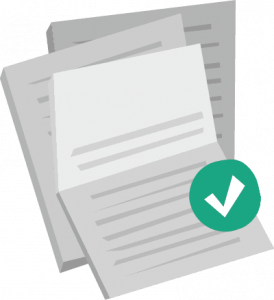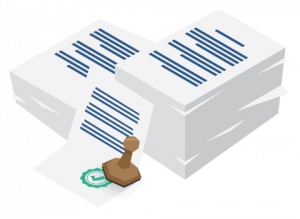Trademark Specimen
A trademark specimen is real-life evidence of your trademark being used in connection to your goods and services in the marketplace. Like a logo on a clothing tag, your specimen proves that your mark is being used in commerce. Making sure to submit the right examples as part of your federal trademark application can be stressful, so we've broken the process down for you here.
In this article, we’ll cover:

What Is a Trademark Specimen?
Trademark specimens allow you to demonstrate how consumers see your mark in connection to what you’re selling. Specimens are required when filing for federal trademark registration with the United States Patent and Trademark Office (USPTO).
If you are filing on a use in commerce basis, you have to upload your specimen(s) as part of the application. This is how you show the examining attorney—the person who decides your application’s fate—proof that your good or service is being offered “in commerce.”
If you need a bit more time to begin using your mark in commerce, you can file an intent-to-use trademark application, which states that you plan to use the mark soon but you aren’t ready to do so yet. However, you’ll still need to submit specimens along with the proper filing (Amendment to Allege Use or Statement of Use) before you can reach registration.
Acceptable trademark specimens depend on whether they’re connected to goods or services. Broadly, they may include photos (or screenshots, as applicable) of:
- Tags on clothing
- E-commerce websites
- Packaging
- Brochures
Your specimen cannot be a mock-up. It also can’t be a sample of the mark being used by someone else, like in a press release exclusively sent to news media. It must be a real example, demonstrating how the trademark is actually being used.
Our Trademark Service experts help make sure your application has the right trademark specimens! Get started on the federal registration process today.
What Are the Requirements for a Specimen?
A main requirement of a trademark specimen is that it must show how your customers see your mark when they purchase your item(s) or service(s). Keep in mind, the specimen must show the trademark connected to your offerings—and the mark must look exactly as it does in your mark drawing. The examining attorney will compare them, so make sure the mark in the specimen is clear and in focus.
Formatting Requirements
An important requirement for uploading your trademark specimens is the filing format and size. If you are filing an image 5 megabytes or smaller, you must upload a JPG.
If you are filing a non-image specimen or an image over 5 megabytes, you can upload any of the following formats up to 30 megabytes in size:
- WAV
- .WMV
- .WMA
- .MP3
- .MPG
- .AVI
Upload Requirements
Your trademark specimens must be digital uploads, not physical copies, and are submitted with your online application through the USPTO’s Trademark Electronic Application System (TEAS).
You must submit at least one specimen per trademark class that you are registering under. To have federal protections in relation to all your goods/services, you have to register in all applicable classes. For example:
- If you sell fishing poles and hats in connection to your trademark, you’ll need to file under both Class 28: Toys & Sporting Goods and Class 25: Clothing. This would require two specimen samples, one for the fishing poles and one for the hats.
If your specimen is unclear in some way, such as a blurry photo or hard to read angle, you might be sent an office action requesting alternative trademark specimens. This could slow down your application’s processing time, so be certain that the uploaded specimen is as clear as possible.
If a single specimen applies to multiple classes, you’ll upload the same specimen for each related class.
Specimens for Goods vs. Services
The specific rules for what counts as a specimen depend on if you are selling goods or services.
Goods are typically items, whereas services are typically experiences. Where and when your customer interacts with your trademark is a bit different depending on if they’re buying a massage or massage oil, for example, so the acceptable specimens are different, too.
Website screenshots are one type of specimen that work well for both goods and services. Just make sure to include both the items being sold and the trademark. And in relation to services, the screenshot should also include a way for consumers to buy them (like an add to cart button) so that it’s clear how the trademark is being used in commerce.
Tip: If you’re including a screenshot from a webpage, make sure to record the screenshot’s date. You’ll need to include that on the application.
Specimens for Goods
A trademark specimen for a good is something that is connected to that item in commerce. This might be a label or tag connected to the item itself, packaging for the item, or a screenshot from a website where the items are sold (as long as the good is in the image).
Can a picture of my good be a specimen?
Yes! If your trademark is on the good itself, such as a logo on the bottom of a coffee mug, then a photo of that likely counts as a valid specimen. If you have to zoom in super close to see the logo, it may be worth providing a zoomed out photo as well, to provide additional context.
Also keep in mind that the trademark featured on the goods has to qualify as a mark—it must be used to differentiate your products from others, not just as decoration.
Can I use marketing materials as a specimen for my goods?
Not usually. TMEP §904.04 states that advertising materials are “generally not” accepted as specimens for goods. Exceptions are rarely applied.
Specimens for Services
Since services typically have no literal packaging, a specimen can be (nearly) anything that consumers see in connection to buying the “experience.” This might be a brochure, website screenshot, or flyer promoting the services. Even business signs and vehicles that feature the trademark could also be considered a valid specimen.
When selecting specimens for your services, be sure to show the mark connected to the sale of your services, as well as an order or contact option.
Can a picture of my advertisement be a specimen for my service?
This depends entirely on the advertisement, but usually, yes. The key here is that your advertisement must clearly connect the mark with the services, your business, and a way for customers to order the services or get in touch. (For example, a teaser photograph posted on your Instagram that includes just your services or just your trademark would likely be denied because they are not seen together at a point of purchase.)
Ultimately, this means you may need to provide multiple specimens in order to cover all the bases.
How many specimens do I need to submit?
One specimen is required for each good/service you are registering the trademark under. However, providing multiple specimens may put your application in a better position.
Frequently Asked Questions
The timing of when you submit trademark specimens depends on if you’re filing use in commerce or intent-to-use. If you file use in commerce, then specimens are included as part of your initial application. If you file intent-to-use, specimen(s) are included in a future filing.
If you submit an application with use-in-commerce basis, you won’t be able to proceed in the application until something is uploaded as a specimen.
If what you upload isn’t a sufficient specimen, you’ll likely receive an office action. You’ll have a chance to respond to the office action with a new specimen.
A drawing (also called a sample) shows what the trademark is, whereas a specimen shows how the trademark is used in commerce. The drawing is a depiction of your mark and should match the specimen you attach to your application. The drawing is also what is shown on USPTO resources such as its Trademark Search and Gazette, which means it is what people looking up your mark will see.
An app can count as a good or a service depending on the use of the app and how consumers pay. For example, an app that has a one time download fee is likely a good—it is something that a consumer can purchase and own. If the app is connected to a subscription, like Spotify, then it is a service.
Generally, regardless of whether your app is a good or a service, a screenshot of where consumers can buy the software, such as the app store or your website, can count as a specimen. Make sure the mark is in clear view. If the app is a good, it can help to provide screenshots of the app in use.
It’s worth consulting with a trademark attorney if you’re not sure which type of offering you have.
If you get an ornamental refusal, it is because the examining attorney thinks your mark on the goods as decoration, not as a brand identifier.
For example, if Taco Bell was selling a T-shirt with only the words “Live Mas” printed on it and used a picture of that as its specimen, the examining attorney might find this ornamental. The price tag with the Taco Bell logo on it connected to the T-shirt, however, is more likely to be approved as a valid specimen.






